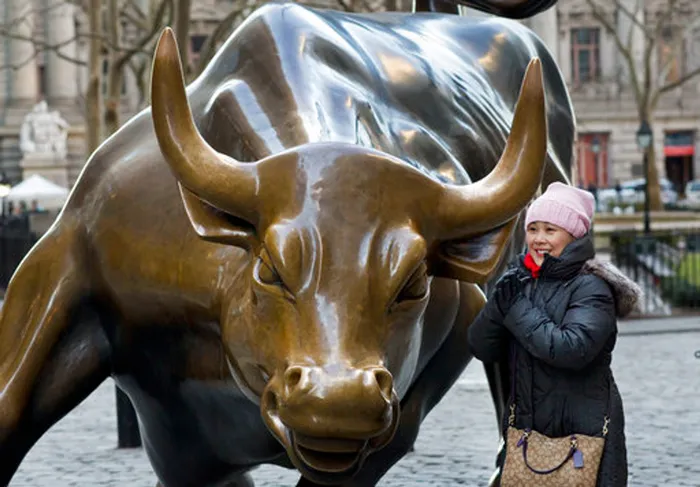Will Trump's 'Liberation' day explode in his face? - Chris Harmse
Markets

A woman poses for photos with the Charging Bull statue in New York. Since 1989 the massive, bronze bull has stood in New York City's financial district as an image of the might and hard-charging spirit of Wall Street. AP Photo/Mark Lennihan A woman poses for photos with the Charging Bull statue in Wall Street New York, an image of the might and hard-charging spirit of Wall Street. At the close on Friday the S&P 500 had lost 10.52% over the two days following US President Donald Trump's announcement of import tariffs on the US's major trading partners on Wednesday.
Image: AP Photo/Mark Lennihan
Chris Harmse
The US president’s “liberation day” tariff policies, announced on Wednesday, have resulted in sweeping border taxes of between 10% and 50% imposed on almost every nation, wiping more than $2.5 trillion (£1.9 trillion) off Wall Street stocks and share prices in other financial centres across the globe on Thursday.
At the close on Friday, the S&P 500 had lost 10.52% over the two days. Over the week, the index is down 8.4% and from the beginning of the year, 14.3%. This is one of the worst performances of the index since the COVID-19 virus outbreak.
Households, despite worries about rising inflation due to the tariff war, are becoming increasingly nervous about possible higher unemployment in the months to come. This is the opposite of what President Trump has in mind with his "Make US Better" tariff policies.
Professor of Economics at Auckland University of Technology, Niven Winchester, has calculated that the tariffs will decrease US GDP by $438.4bn (1.45%). Divided among the nation’s 126 million households, GDP per household decreases by $3,487 per year. That is larger than the corresponding decreases in any other country. (All figures are in US dollars.)
The non-farm payrolls for the US released on Friday already concur with the fear that the US economy will start to suffer under the tariff war, as feared by households. Unemployment in March increased to 4.2% from 4.1% in February, despite the increase of 228 000 new jobs in March 2025, beating forecasts of 135 000.
On April 3, President Trump announced his so-called “liberation day” tariff, imposing a 31% tariff on all imports from South Africa. With this announcement, he effectively scrapped the AGOA agreement, which allowed South Africa to be free from certain tariffs for specific agricultural and motor exports to the USA.
The 31% tariff increase on all South African exports is likely to lead to a much weaker Rand and the inflation rate to move quickly toward the midpoint of 4.5% set by the Reserve Bank. The Rand had depreciated by more than 100 cents during the ten days leading up to the Trump announcement, trading at R19.09 on April 4, 2025.
On the JSE, shares were not spared in reaction to the massive increase in US tariffs on global exports to the US. The ALSI lost 8,496 points or 9.42%. The index is only 2.4% in the green for the year, and it is expected that most global indices will move into negative territories in the months to come as more and more data becomes available, making global stagflation (negative economic growth with surging inflation) more likely.
On the positive side, new vehicle sales in South Africa increased in March 2025 by 5 504 units to 49 493 units. This reflects an increase of 12.5% compared to the 43 989 vehicles sold in March 2024. Export sales increased by 9 354 units, reaching 39 477 in March 2025.
This represents an increase of 31.1% in vehicles exported compared to March 2024. However, this number will come under pressure in the months to come as the Trump tariffs start to affect exports.
Domestically, the market awaits the release of South Africa’s manufacturing production sales for February 2025 on Wednesday. It is expected that it will decrease by -1.0% over the last year, against the annual decrease of -3.3% in January 2025.
On global markets, investors are waiting for the release of the US FOMC minutes from its March meeting on Wednesday and the inflation rate for March 2025. It is expected that the USA core CPI has increased by 3%, marginally lower than the 3.1% in February 2025.

Chris Harmse is the consulting economist of Sequoia Capital Management and a senior lecturer at Stadio Higher Education.
Image: Supplied
Chris Harmse is the consulting economist of Sequoia Capital Management and a senior lecturer at Stadio Higher Education.
** The views expressed do not necessarily reflect the views of IOL or Independent Media.
BUSINESS REPORT